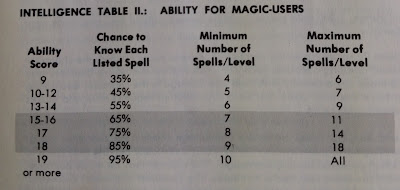I often find rules in D&D that don’t work the way I expect them to, and blame my younger self for having been too lazy to learn the rules correctly back in the day.
Turns out, I’m usually just remembering Holmes Basic.
This came up recently, when a campaign decided to switch from LL to AD&D, and I was ready to rock this table:
My spell caster was going to get a massive upgrade to his spell book! With INT 18, he was going to go from five spells to at least 18! He had a good chance of making a clean sweep.
Then someone kindly pointed out that the above percentages apply to learning spells that you find lying around amongst owlbear pellets. It takes Gygax about five paragraphs to explain this chart, and... well, let's say that clarity is not among its virtues.
To summarize:
To summarize the summary: You only have one chance to learn a spell that you find, unless you have a second chance, or if you find a spell.
Here’s the previous iteration of the Spells Known Table from Holmes Basic:
Ah. See, that makes sense. It’s a little chargen mini-game to find out what’s in your spell book.
Of course, Holmesian spell books are massive, immobile tomes that spell casters have to leave at home, and they can only recharge their spells by trekking all the way back. No one-hour study sessions around the campfire for these wizards. Given this lack of portability, it’s nice that they have a bit more selection.
And how adorable is it that you could have a magic user with INT 3?
Moldvay Basic, quite sensibly, doesn’t truck with any of this:
Turns out, I’m usually just remembering Holmes Basic.
This came up recently, when a campaign decided to switch from LL to AD&D, and I was ready to rock this table:
My spell caster was going to get a massive upgrade to his spell book! With INT 18, he was going to go from five spells to at least 18! He had a good chance of making a clean sweep.
Then someone kindly pointed out that the above percentages apply to learning spells that you find lying around amongst owlbear pellets. It takes Gygax about five paragraphs to explain this chart, and... well, let's say that clarity is not among its virtues.
To summarize:
- If a spell caster finds a spell, they can roll their percentile chance to learn the spell.
- This roll can only be made once. If you fail to learn a spell, you can never learn it.
- Except you can make this roll more than once, because there’s a minimum number of spells you can learn.
- But when do you make this second attempt? If this is a roll you make after finding a spell, do you have to find and fail to learn every spell on your list so that you know you haven’t met your minimum, and then find them a second time to roll again? Or do you roll twice each time you find a spell until your minimum has been met?
- And then check out this sentence: “Although the magic-user must immediately cease checking to determine if spells are known after the first complete check of each spell in the level group, or immediately thereafter during successive checks when the minimum number of spells which can be known is reached, it is possible to acquire knowledge of additional spells previously unknown as long as this does not violate the maximum number of spells which can be known.” Jeeziz, Gary.
- The “previously unknown” spells referred to in that sentence are, apparently, once found on scrolls or in spell books. Which… is exactly what the previous mechanics were also supposed to be for, right?
- And if anything happens to change your intelligence, you have to recalculate all of whatever this mess is.
To summarize the summary: You only have one chance to learn a spell that you find, unless you have a second chance, or if you find a spell.
Here’s the previous iteration of the Spells Known Table from Holmes Basic:
Ah. See, that makes sense. It’s a little chargen mini-game to find out what’s in your spell book.
Of course, Holmesian spell books are massive, immobile tomes that spell casters have to leave at home, and they can only recharge their spells by trekking all the way back. No one-hour study sessions around the campfire for these wizards. Given this lack of portability, it’s nice that they have a bit more selection.
And how adorable is it that you could have a magic user with INT 3?
Moldvay Basic, quite sensibly, doesn’t truck with any of this:
Each magic-user and elf has a spell book for the spells that he or she has learned. A first level character will only have one spell (a first level spell) in the spell book. A second level character will have two spells (both first level) in the spell book; a third level character will have three spells (two first level spells and one second level spell) in the spell book. The DM may choose which spells a character has in the book, or may allow the player to select them.And Cook Expert only adds that a spell-caster has to spend a week with guild masters when leveling up to learn these new spells.



Comments
Post a Comment